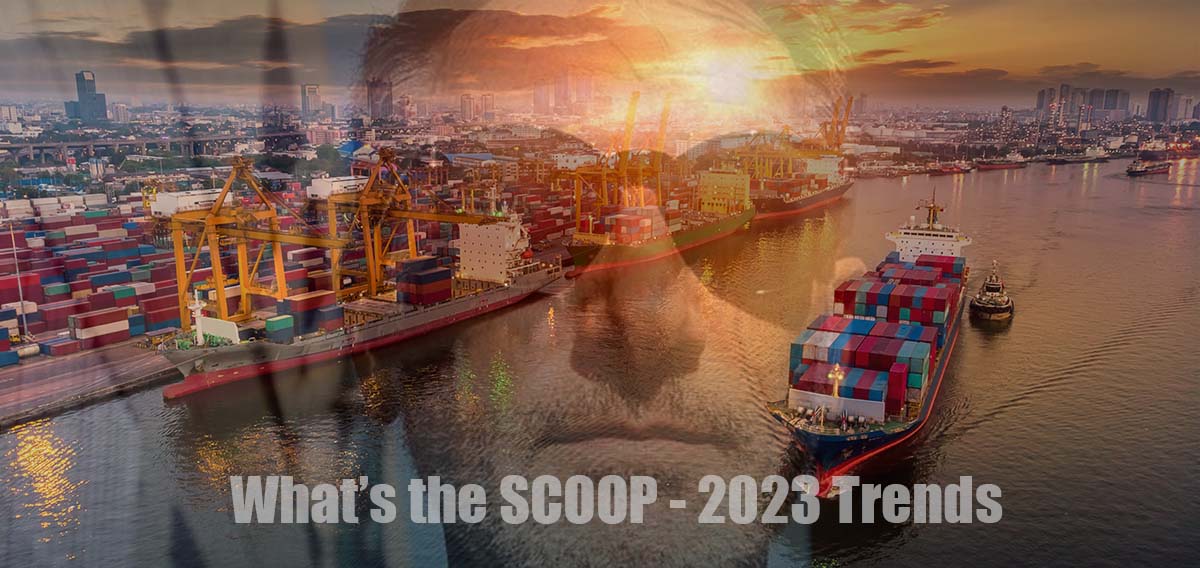What’s the SCOOP – 2023 Trends – part two

By Philip Spagnoli Stoten
It’s been a good year for the EMS industry in general, and with better component availability it would have been even better. But how is everyone in the industry feeling about 2023? I reached out to around 50 CEOs and many responses are in. Take a look at what those running EMS companies and those the companies that supply them as well as a smattering of what consultants, experts and economists think.
We’ll be serializing the thoughts and musing of the industry’s great and good over the coming week and wrapping that series up with an e-book in January. I’ve started interviewing some of those that contributed and you can watch those interviews in the EMS@C-Level youtube playlist, or listen to the EMS@C-Level podcast on buzzsprout or wherever you get your podcast. If you have an option and want to share it, write to me in less than 400 words and we can add it to the mix. If you don’t have my email address hit me up on LinkedIn.
 Andreas Schneider, COO of BMK
Andreas Schneider, COO of BMK
The main topic for 2023 will be securing deliveries, as for the past two years. The electronics world has been in an unprecedented allocation situation. BMK, as a solid, owner-managed company, is taking on the challenges quickly and proactively with automation, digitalization, innovative processes, and an expansion of the service portfolio. BMKyourproto portal, the new communication platform for prototypes, is a great example of BMK breaking completely new ground and by means of instant communication, the lead time to produce prototypes is considerably reduced.
We have innovative customers who are working on more efficient energy consumption and turnaround and on enhanced data security. Our customers offer new technologies such as storage systems or e-fueling stations. These companies trust BMK, because we offer more than just the classic EMS services including procurement.
Our daily routine revolves around finding solutions to complex problems in the supply chain. Our customers benefit from additional services like pro-actively searching for alternative parts for a product redesign, escalation management, and flexible personalized manufacturing in combination with logistics concepts.
The turn towards sustainability is also noticeable in after-sales service. We support our customers to re-use down to chip level through rework and repairs. We are seeing strong demand in refurbishment and component recovery and reuse through desoldering.
BMK can weather the crisis and was once again awarded “Bavaria’s Best 50” in 2022. This makes BMK one of the fastest-growing medium-sized companies in Bavaria, and despite continued challenging times in 2023, we plan to continue to invest and grow.
 Günter Lauber, CEO at ASMPT SMT Solutions Segment
Günter Lauber, CEO at ASMPT SMT Solutions Segment
The digital transformation has many faces. In electronics manufacturing, the focus is frequently on Industry 4.0 or the ‘integrated smart factory’, as we call it. You don’t have to be visionary to realize that the factors by which suppliers in our industry will continue to be measured in 2023 are M2M and M2H communication, the networking of enterprise solutions, the use of artificial intelligence or natural language processing, and most of all the convergence of hardware and software on the basis of open standards.
The desire for automation will prevail above all. For far too long, proprietary systems, rigid production processes and restrictions regarding the degree and speed of automation have restricted the financial and technical latitude for electronics manufacturers. The road to the integrated smart factory is still an obstacle course, which is why it was time for us to break up these dependencies.
With ‘Open Automation’, we have presented an intelligent and practical concept that allows our customers to implement automation in an individual, modular and step-by-step manner that also includes third-party equipment and retrofit solutions. In doing so, we have put our understanding of freedom and independence into practice. For quite some time, we have been investing into the development of best-in-class machines as well as of line management software that improves productivity and efficiency. In the SMT field, for example, we offer the smart management suite WORKS for seamless connectivity on the shop floor. And in the coming years we will work with our partners to close the last remaining gaps between the line and enterprise levels with a comprehensive software offering. The path to Industry 4.0 is thus clear.
The developments in our industry segment have also led to a different kind of transformation for our company. The transition of ASMPT to a holistic provider of software, hardware and services became even more apparent in August of this year with our global rebranding. All business units, regions and segments are united as ONE company under the same brand: ASMPT. As you can see, the digital transformation has many faces, but it always speaks the same language.
Charles Tonna, Executive Vice President Operations at Microart
We all want to plan for 2023 and make predictions, but this year we have barely been able to catch our breath. Planning is a challenge when you’re dealing with constant disruption and the highs and lows we now associate with EMS. Highs we like include our best ever orderbook and a team that are consistently showing the grit and determination to meet our customers demands. Highs we like less include our highest levels of work in progress and inventory ever, which results in an increasing demand for working capital. Among the lows are the lowest on-time-delivery performance I can remember throughout the supply chain. That and the constant rescheduling or failure to deliver parts when expected are my lows.
But perhaps it is the challenge that drives us, the opportunity to solve problems, the people, the customer satisfaction and recognition, and at the end of the day the simple “thank you” for a job well done in difficult circumstances. I hope that in the coming months we move back to a time where partnership means partnership, team means team, and gratitude is shared throughout the value chain. In 2023 this is ultimately my prediction, we are all going to get a little nicer and it is the simple things that will make it all a little better. Beyond that the demand bubble may deflate a little, supply chain could, and should, improve and people may want to come back to work, certainly talent issues are starting to ease. In 2024 cost down, lean philosophies, and just in time inventories may come back onto strategic plans, but for 2023 I predict more of the same with a focus on better relationships and more transparency from all.
 Georg Steinberger, Semiconductor Industry and Marketing Expert
Georg Steinberger, Semiconductor Industry and Marketing Expert
2022 in Europe offered everything from pandemic to war to supply chain disruption to massive allocation of key technologies, only to end with the gloomiest outlook on the economy and talk of recession.
In the electronic components market, the pendulum that started to swing to the positive side last year (demand surge, overbookings, price increases), was expected to swing back violently towards the dark side this year. It didn’t yet, or at least not everywhere. While the market served directly by manufacturers slowed down over last few months from double-digit growth versus last year to single-digit decline in September, the market served by distributors in Europe – European DTAM runs between 30 and 40% of the total available market – has an annual run rate of over 30% growth across components and will end over 30% in 2022.
Record component distribution revenue has several factors: allocation and price increases, inflation, exchange rate swing towards a very strong dollar and the hauling-in of 2023 demands, driven by fear of ongoing shortages. So, this +20-billion-Euro business is heading exactly where? No one knows.
The advantage of components distribution in Europe is that it mainly stays away from the two market drivers: processors and memories. They are consumed like commodities for servers, smartphones, data centers and notebooks in good times and lying on manufacturers’ shelves even at big discounts in bad times.
Distribution mainly means Industrial and Automotive, where power devices, microcontrollers and high-value analog parts are needed. Here the demand is still high, especially from the Automotive industry who invest heavily in e-mobility or Industrial which drive a wide variety of high-complex growth markets like IoT, Industry 4.0 and others.
Clearly, some of the demand for coming quarters has already been realized, so 2023 could see a significant correction (even double-digit), but the longer-term outlook is brilliant for Europe, as the market here is much less volatile (although the big question mark is on e-vehicles and automotive in general) and less demanding from a leading edge-technology perspective. And it is even better for distribution, who are here to serve the market (while manufacturers may look to greener pastures that offer more critical mass).
 Frank Zycinski, Market Sector VP EMEA, Plexus
Frank Zycinski, Market Sector VP EMEA, Plexus
Two industries to watch in 2023:
- Aerospace and Defence facing challenges: Perhaps the greatest challenge facing customers in the aerospace and defence sector is the reality of supply-chain disruptions arising from a confluence of industry-wide and geopolitical factors. It is said that war is often the mother of invention but innovation has been stymied by ongoing material and workforce shortages. In order to meet the demands of governments as the conflict continues into 2023, suppliers will need to strategically adjust their operations plan to become more agile and deliver high-quality, cost-competitive products at speed. Another trend we have observed in the sector is the capacity / capability gap between non-traditional aerospace and defence start-ups and their established counterparts. While these newcomers are shifting the competitive landscape with innovative and disruptive technologies, they may need expert support in areas such as supply chain risk management and full-scale manufacturing if they are to realise their growth goals.
- The future of energy management: As organisations mobilise to decarbonise their processes, finding new ways to manage and reduce energy consumption has become essential. Bigger companies are able to be more ambitious when it comes to setting net-zero targets, but across the board we expect investment in renewable energy infrastructure to increase significantly in 2023. EV destination charging in particular is identified as an area of growth as businesses look to prioritise the electrification of their transportation networks. The number of EV chargers in the UK increased by 34% in 2022 offering a clear indication of the direction of travel. Similarly, the use of hydrogen as an energy source to power heavy industrial equipment and processes is something manufacturers worldwide are beginning to explore. Meanwhile, the vast scale-up of battery-based electricity storage infrastructure is widely seen as central to the UK and Europe’s net-zero ambitions.
 Zeev Efrat, CEO, Cybord
Zeev Efrat, CEO, Cybord
This year was a breakout year for Cybord. We launched our platform for component analysis solutions and traceability. Came out of stealth mode, completed a successful funding round, and ended the year having inspected more than three billion components. Not bad for a startup!
The major trend driving the industry in 2022 was component shortages, and I expect more of the same in 2023. The demands in the market are shifting to more industrial electronic components that are still in shortage. Yes, some parts are easing, and a softening in demand due to economic factors may ease things further, but rest assured, it won’t all be fixed when we get back in the new year.
The shortages are just one factor that has led OEMs and some forward-thinking EMS companies to adopt a zero-trust approach to the supply chain that requires 100% inspection of the parts they use. This year our AI-driven software has inspected billions of parts at goods inward, on the placement machine, and at the AOI stage, all to provide quality assurance and surgical traceability that improves yield and performance in the field and massively reduces any potential recall.
Predicting the future is no easy task, but I am confident that the companies that will thrive in 2023 and beyond are those that embrace digital transformation, AI, automation, the digital twin, and every other aspect of Industry 4.0.
OEMs want manufacturing partners that have complete control over their manufacturing processes and supply chains, which comes when this zero-trust ideology is applied. If we’d got to the end of 2022, inspected billions of parts, and found no issues, I’d say don’t bother. But the truth is there are a lot of component issues that can cause massive damage to a product’s reliability and to a brand’s reputation.
So, there you have it: zero-trust supply chains, more automation AI, continued growth in electronic demand, and slowly but surely the easing of component shortages.


 Andreas Schneider, COO of BMK
Andreas Schneider, COO of BMK Günter Lauber, CEO at ASMPT SMT Solutions Segment
Günter Lauber, CEO at ASMPT SMT Solutions Segment
 Georg Steinberger, Semiconductor Industry and Marketing Expert
Georg Steinberger, Semiconductor Industry and Marketing Expert Frank Zycinski, Market Sector VP EMEA, Plexus
Frank Zycinski, Market Sector VP EMEA, Plexus  Zeev Efrat, CEO, Cybord
Zeev Efrat, CEO, Cybord








